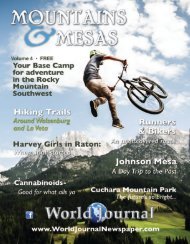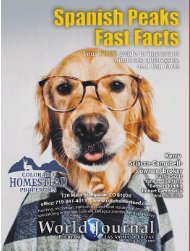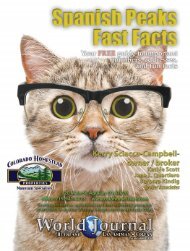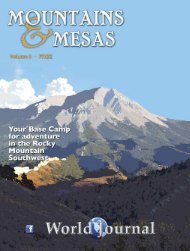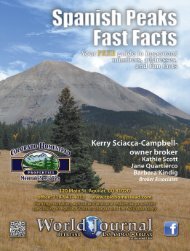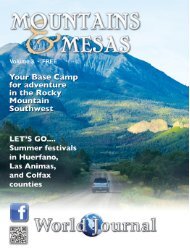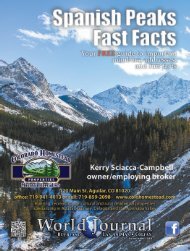You also want an ePaper? Increase the reach of your titles
YUMPU automatically turns print PDFs into web optimized ePapers that Google loves.
Early in 1868 Kit Carson and his family moved to Boggsville,
and lived in the same house as the Houghs. It was during
this time that Carson gave Hough one of his Native American
leather coats, which Hough treasured for the rest of his life, before
bequeathing it to the state of Colorado.
building a borough with baca
Life in northern New Mexico had changed. The Mexican
War of Independence had ended and the newly independent
Mexico claimed New Mexico as its province, opening the area
to American trade. The Santa Fe Trail had opened up a vital
transportation route. Trade goods from the east were passing
through on caravans headed for Santa Fe. The Mexican-American
War had seen General Stephen Kearny and his army seize
Santa Fe to the south which ultimately brought New Mexico
under full U.S. control. But the farmers and ranchers of the narrow
river valleys along the Rio Grande and its tributaries had
called this place home since the early sixteenth century. The Hispano
settlers had found prime grazing land and were successful
at what they knew, so they remained.
It was one farmer, traveling the Santa Fe Trail on his way to
Denver to sell a load of flour, who changed the future of many
of the families of northern New Mexico. When he crossed over
Raton Pass and into the Purgatoire River valley, Felipe Baca saw
what he believed to be prime, fertile lands that had potential for
agriculture and grazing and told himself he would stop on his
way home to see more. That fall, Baca left his home in Taos,
New Mexico, and laid claim to a choice piece of bottomland in
the valley to the north. After a successful harvest, he returned
home, with a wagon full of melons and grain. His advertising
of the farming advantages of the new-found land induced many
to follow him to Colorado. Twenty ox-drawn wagons, loaded
to the hilt with all their belongings, brought 12 families to the
area of the Rio de las Animas Perdidas en Purgatorio - shortened
Mountains & Mesas Page 27
to Purgatoire River by later French settlers. The journey was
without mishap until they reached the steep incline of the pass.
There, several of the wagons rolled over, but no serious damage
was done. And although the men were armed and ready, no
Native American attack occurred.
By 1865 the settlement had increased in population to twelve
hundred and it had reached the point where it needed a church
for its Catholic population. And so Don Felipe donated land.
The church built by him was no more than four adobe walls with
a dirt roof, the floor being the bare ground. It served the congregation
until 1885, and was called “Santisima Trinidad” (Holy
Trinity) from which the city of Trinidad was given its name.
Having outgrown the small house originally built for his
family, Felipe and Dolores Baca traded 22,000 pounds of wool
for an unusual adobe house built on a hill along the Santa Fe
Trail: the house originally built for John Hough.
The Hispano farmer and sheep rancher, Don Felipe de Jesus
Baca, was one of the first settlers of the Purgatoire River valley,
and historical records note that he was one of the most important
developers of Trinidad.
wily wootton adapted to the
demands of life out west
Seventeen-year-old Richens Lacy Wootton, tired of the life
in Kentucky with his parents and moved to Mississippi to work
on his uncle’s cotton plantation. It wasn’t two years later that
he made his way to Independence, Missouri, and found a job
working on a wagon train run by the Bent, St. Vrain & Co. Richens
soon found himself at Bent’s Fort, the only major permanent
white settlement on the Santa Fe Trail. He met many explorers,
pioneers, traders, and trappers, and became enamored with the
life. For the next several years he lived as a trapper and traded
among the Native Americans of the Rocky Mountains. By 1840,




